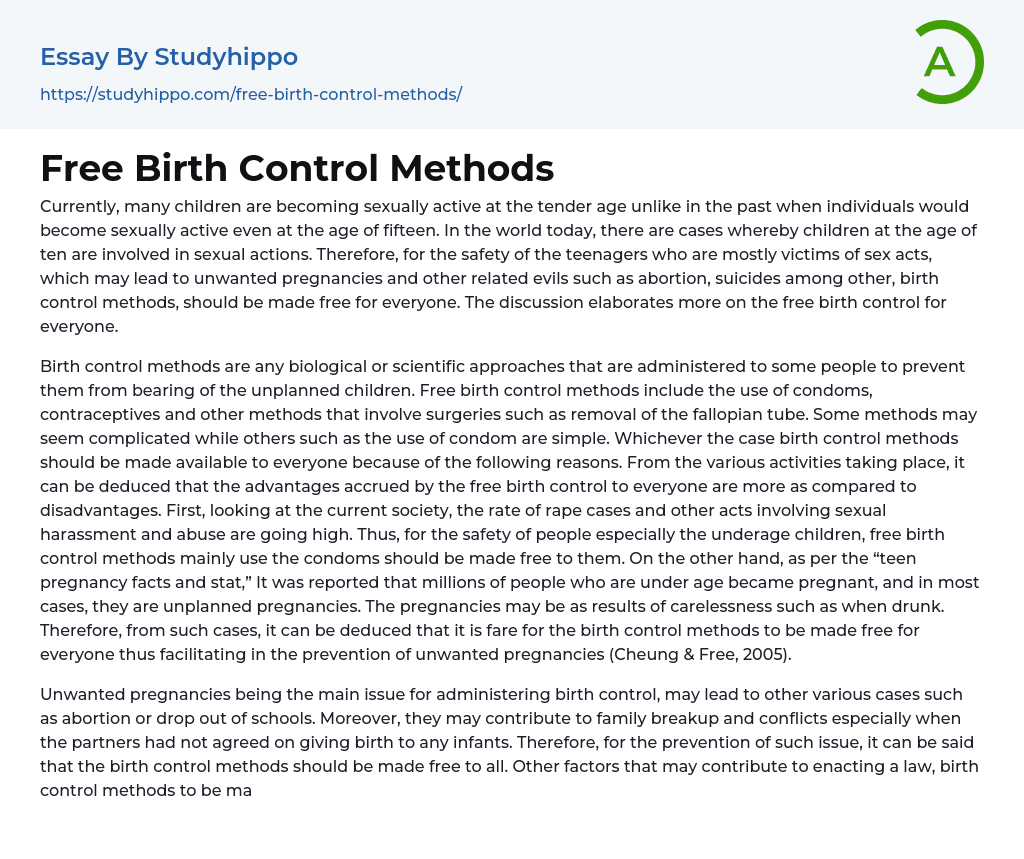Previously, individuals would wait until they were fifteen years old to participate in sexual activity. However, nowadays, numerous children are becoming sexually active at a young age.
In order to protect teenagers from getting involved in sexual activities at a young age and the potential consequences like unintended pregnancies, abortions, and suicides, it is crucial to guarantee that everyone has easy access to free birth control methods. This discussion highlights the significance of ensuring that birth control is available for all people. Birth control methods include different biological or scientific interventions designed to prevent unplanned pregnancies. Free birth control methods consist of items such as condoms, contraceptives, and surgical procedures like fallopian tube removal.
Although some birth control methods may seem complicated, others like condoms are simple. However, it is important to guarantee widespread availability of these methods. Ther
...e are several reasons that support this suggestion. After examining different activities, it becomes clear that the advantages of providing free birth control to everyone are greater than the disadvantages. Most importantly, given the high occurrence of sexual assault and abuse in our society, offering free birth control methods—especially condoms—is crucial for protecting people's welfare, especially minors.
Studies on "teen pregnancy facts and stats" indicate that a significant portion of underage individuals experience unplanned pregnancies, often due to irresponsible behavior like engaging in sexual activities while under the influence. As a result, it is argued that providing free contraception access for all is both fair and essential in preventing unwanted pregnancies (Cheung & Free, 2005). Unwanted pregnancies are concerning because they can lead to further complications such as abortions or students dropping out of school. Additionally, they can contribute to
family conflicts and separations, especially when partners have not agreed on whether or not to have children.
Offering free birth control methods to everyone is a possible solution to tackle these problems. It can effectively reduce emotional distress and potentially life-threatening circumstances like abortion or suicide, particularly among teenagers. Having an abortion can cause intense emotional trauma that negatively affects a woman's overall perspective on life. Furthermore, it can result in infertility, preventing her from conceiving when she wants to and potentially causing conflicts within the family and separation.
To address the issue of unplanned and undesired pregnancies, one solution is to legalize and offer free birth control for everyone. The funding for this initiative can come from donations made by different organizations and individuals who are willing to contribute a portion of the necessary funds. Moreover, it is suggested that the government implement regulations mandating individuals to allocate a small percentage of their earnings towards financing the provision of free contraception methods for all. Additionally, foreign aid organizations can also help contribute the needed capital to ensure universal availability of birth control.
By preventing births, it is possible to enhance the quality of life for numerous individuals and foster a prosperous and advanced society. Often, unplanned pregnancies lead to inadequate parental support, especially among teenagers who are unprepared for parenthood. Consequently, these children often end up being cared for by elderly mothers and relatives. Additionally, unwanted pregnancies can exacerbate poverty levels and hinder educational opportunities, resulting in unproductive citizens. Furthermore, communities with high rates of unintended pregnancies tend to witness a rise in criminal activities. This lack of concern for children can contribute to moral decay within
the community.
To address the issue and create a better future, it is essential to ensure freely accessible birth control methods. This includes contraceptives, condoms, and other scientific approaches. Condom distribution should be legally allowed and provided at no cost for everyone. However, contraceptive use should be sold to prevent misuse (Amy & Tripathi, 2009). If contraceptives were made free of charge, this policy should solely apply to married couples.
Offering free birth control to married individuals can be a solution to tackle overpopulation and yield positive outcomes for both individuals and society. By regulating birth rates, society can effectively manage population growth and promote a more stable economy. Although there may be concerns about an increase in immoral behavior among teenagers, the benefits outweigh the drawbacks. Thus, it is evident that providing complimentary contraception methods is an effective approach to reducing unplanned pregnancies, decreasing abortion rates, and improving citizens' quality of life through population control.
Legalizing the use of birth control is essential to ensure universal accessibility, and it requires collaboration between individuals, organizations, and governments.
References
- Amy, J. J., ; Tripathi, V. (2009). Contraception for women: an evidence based overview. BMj, 339(7), b2895.
- Cheung, E., ; Free, C. (2005). Factors influencing young women's decision making regarding hormonal contraceptives: a qualitative study. Contraception, 71(6), 426-431.




